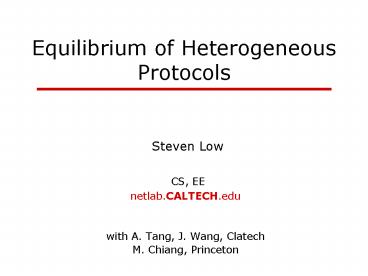Equilibrium of Heterogeneous Protocols - PowerPoint PPT Presentation
1 / 24
Title:
Equilibrium of Heterogeneous Protocols
Description:
fair? Dynamics: stable? limit cycle? chaotic? Practical networks: typical behavior? design guidelines? Summary: equilibrium structure. Uni-protocol. Unique ... – PowerPoint PPT presentation
Number of Views:50
Avg rating:3.0/5.0
Title: Equilibrium of Heterogeneous Protocols
1
Equilibrium of Heterogeneous Protocols
- Steven Low
- CS, EE
- netlab.CALTECH.edu
- with A. Tang, J. Wang, Clatech
- M. Chiang, Princeton
2
Network model
3
Network model example
TCP Reno currently deployed TCP
AI
MD
TailDrop
4
Network model example
TCP FAST high speed version of Vegas
5
Duality model
- TCP-AQM
- Equilibrium (x,p) primal-dual optimal
- F determines utility function U
- G determines complementary slackness condition
- p are Lagrange multipliers
- Uniqueness of equilibrium
- x is unique when U is strictly concave
- p is unique when R has full row rank
6
Duality model
- TCP-AQM
- Equilibrium (x,p) primal-dual optimal
- F determines utility function U
- G determines complementary slackness condition
- p are Lagrange multipliers
The underlying concave program also leads to
simple dynamic behavior
7
Duality model
- Global stability in absence of feedback delay
- Lyapunov function
- Kelly, Maulloo Tan (1988)
- Gradient projection
- Low Lapsley (1999)
- Singular perturbations
- Kunniyur Srikant (2002)
- Passivity approach
- Wen Arcat (2004)
- Linear stability in presence of feedback delay
- Nyquist criteria
- Paganini, Doyle, Low (2001), Vinnicombe (2002),
Kunniyur Srikant (2003) - Global stability in presence of feedback delay
- Lyapunov-Krasovskii, SoSTool
- Papachristodoulou (2005)
- Global nonlinear invariance theory
- Ranjan, La Abed (2004, delay-independent)
8
Duality model
- Equilibrium (x,p) primal-dual optimal
(Mo Walrand 00)
9
Congestion control
10
Heterogeneous protocols
11
Multiple equilibria multiple constraint sets
eq 2
eq 1
Tang, Wang, Hegde, Low, Telecom Systems, 2005
12
Multiple equilibria multiple constraint sets
eq 2
eq 3 (unstable)
eq 1
Tang, Wang, Hegde, Low, Telecom Systems, 2005
13
Multiple equilibria single constraint sets
1
1
- Smallest example for multiple equilibria
- Single constraint set but infinitely many
equilibria - J1 prices are non-unique but rates are unique
- Jgt1 prices and rates are both non-unique
14
Multi-protocol Jgt1
- TCP-AQM equilibrium p
- Duality model no longer applies !
- pl can no longer serve as Lagrange multiplier
15
Multi-protocol Jgt1
- TCP-AQM equilibrium p
- Need to re-examine all issues
- Equilibrium exists? unique? efficient? fair?
- Dynamics stable? limit cycle? chaotic?
- Practical networks typical behavior? design
guidelines?
16
Summary equilibrium structure
- Uni-protocol
- Unique bottleneck set
- Unique rates prices
17
Multi-protocol Jgt1
- TCP-AQM equilibrium p
- Simpler notation equilibrium p iff
18
Multi-protocol Jgt1
- Linearized gradient projection algorithm
19
Results existence of equilibrium
- Equilibrium p always exists despite lack of
underlying utility maximization - Generally non-unique
- Network with unique bottleneck set but
uncountably many equilibria - Network with non-unique bottleneck sets each
having unique equilibrium
20
Results regular networks
- Regular networks all equilibria p are locally
unique, i.e.
21
Results regular networks
- Regular networks all equilibria p are locally
unique - Theorem (Tang, Wang, Low, Chiang, Infocom 2005)
- Almost all networks are regular
- Regular networks have finitely many and odd
number of equilibria (e.g. 1) - Proof Sards Theorem and Index Theorem
22
Results regular networks
- Proof idea
- Sards Theorem critical value of cont diff
functions over open set has measure zero - Apply to y(p) c on each bottleneck set ?
regularity - Compact equilibrium set ? finiteness
23
Results regular networks
- Proof idea
- Poincare-Hopf Index Theorem if there exists a
- vector field s.t. dv/dp non-singular, then
- Gradient projection algorithm defines such a
vector field - Index theorem implies odd equilibria
24
Results global uniqueness
- Linearized gradient projection algorithm
- Theorem (Tang, Wang, Low, Chiang, Infocom 2005)
- If all equilibria p all locally stable, then it
is globally unique
- Proof idea
- For all equilibrium p
25
Results global uniqueness
- Theorem (Tang, Wang, Low, Chiang, Infocom 2005)
- For J1, equilibrium p is globally unique if R is
full rank (Mo Walrand ToN 2000) - For Jgt1, equilibrium p is globally unique if J(p)
is negative definite over a certain set
26
Results global uniqueness
- Theorem (Tang, Wang, Low, Chiang, Infocom 2005)
- If price mapping functions mlj are similar,
then equilibrium p is globally unique - If price mapping functions mlj are linear and
link-independent, then equilibrium p is globally
unique
27
Summary equilibrium structure
- Uni-protocol
- Unique bottleneck set
- Unique rates prices
28
Experiments non-uniqueness
- Discovered examples guided by theory
- Numerical examples
- NS2 simulations (Reno Vegas)
- DummyNet experiments (Reno FAST)
- Practical network??































